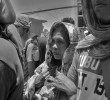Journalists and human rights groups are marking November 23 as the International Day to End Impunity, in remembrance of the 2009 Ampatuan Massacre, which according to International Freedom of Expression Exchange is “the single deadliest incident for journalists in recent history.”
By AMIRA ALI LIDASAN
It’s the third year of the Ampatuan Massacre, the mass killing of 58 people — many of them journalists and media workers — by private army and local police upon the order of (and even led by) the Ampatuans, the most influential political clan in Maguindanao during the reign of former President Gloria Macapagal-Arroyo.
Journalists and human rights groups are marking November 23 as the International Day to End Impunity, in remembrance of the 2009 Ampatuan Massacre, which according to International Freedom of Expression Exchange is “the single deadliest incident for journalists in recent history.”
Of the 58 people murdered, 32 were journalists and two lawyers who accompanied the wife and sister of then gubernatorial aspirant Esmael Mangudadatu for the filing of his certificate of candidacy. The rest of the victims were passersby who were trapped at a police and paramilitary checkpoint set-up for the purpose of stopping the Mangudadatu party.
The scene of the crime was the most gruesome for witnesses: a scene played over and over again on national television and days later, and which proliferated in local DVD stores. The backhoe equipment became the symbol of a crime that was being covered up, just like President Arroyo and other politicians who tried to shield the Ampatuans from culpability. Most of Arroyo’s minions benefited from the electoral machinations of the Ampatuan clan during the 2004 and 2007 national elections.
It was the clear picture of impunity, defined by Bangkok-based Southeast Asian Press Alliance as the “chronic failure by states, judiciary and law enforcement agencies to bring perpetrators to justice.” (Rosauro, 2011) Despite of the high profile arrest ordered by President Arroyo coupled with the declaration of State of Emergency in Maguindanao on December 2009, only 99 of the 197 suspects were arrested including the patriarch Andal Ampatuan and his sons who were serving as governor of the Autonomous Regional in Muslim Mindanao (ARMM) and mayors in Maguindanao.
The State of Emergency was meant to cover up President Arroyo and the Philippine military’s connections with the Ampatuans and culpability to the crime. Not only to hide electoral machinations, but to subdue the 2,000 to 5,000 militia that the military recruited and trained as auxiliary forces for counter-insurgency under the Executive Order 546 she issued in 2004 (Diola, 2012). The commander of the 6th Infantry Division during the massacre, Maj. Gen. Alfredo Cayton was even promoted even if the Ampatuans and the militias were supposedly under his command responsibility and jurisdiction.
Three years after, families and rights groups bewail the slow wheels of justice and court decisions that favor the Ampatuans. Last week, the Supreme Court granted the motion filed by Andal Ampatuan Jr. to prohibit live media broadcast of the trial, reversing its earlier decision last June 14, 2011. This casts doubts on the court’s responsibility to inform the public and deliver justice to the victims.
Aside from the fact that the trial has taken so long, only 81 were indicted, not to mention that several witnesses have been killed, the manner by which was as brutal as the massacre itself. Of the witnesses killed, only four were identified as those who went out of the witness protection program provided by the government.
The Aquino administration is banking on the appointment of former chair of the government peace panel Marvic Leonen as Supreme Court Associate Justice to speed up the judicial process. This appeared to be another means to cover-up the lack of political will on the part of President Benigno Aquino III to end impunity. He could have also paid attention to calls made by the victims’ families to file a case against former President Arroyo for coddling the Ampatuans.
For how will the victims be comforted with an administration that merely continued his predecessor’s measures in tackling the Ampatuan’s crime? The Aquino administration did not lift the State of Emergency in Maguindanao — which is taking its toll on the civilians instead of the perpetrators of the massacre — nor is it repealing EO546. According to Kawagib Human Rights Alliance, the government is deploying more troops in the area and conducting arrests and rounding up of civilians.
On the other hand, President Aquino and his office-in-charge ARMM governor Mujiv Hataman gave a “good housekeeping” award to two Ampatuan grandsons who are mayors in Maguindanao. In the coming 2013 elections, reports of in-laws of Ampatuans are running under the Liberal Party ticket (Mindanews, 2012).
The approach of President Aquino to the problems in Mindanao is similar or merely a continuation of the tact of the previous administration. Despite Aquino’s refusal to admit continuing human rights violations under his presidency, the data speak for themselves. He cannot cover-up the reported extrajudicial killings, child rights violations, illegal arrests and massacre happening in Mindanao.
In a statement released by Manilakbayan Mindanao, a Mindanao Peoples’ Mobilization for the Defense of Land, the Environment, and Human Rights, there are already 24 indigenous peoples’ leaders extra-judicially killed by state security forces or private armed groups of mining companies from June 2010 to October 2012. There are 32 environment advocates killed, among them were Italian missionary Father Fausto
Tentorio in Arakan, North Cotabato; Blaan Juvy Capion in Kiblawan, Davao del Sur; Matigsalog chieftain Jimmy Liguyon from Dao, San Fernando, Bukidnon; Jenesis Ambason from the Banwaon tribe in San Luis, Agusan del Sur and Gilbert Paborada of Higaonon from Misamis Oriental.
The local policies following the Global War on Terror — State of Lawlessness and Rewards for Justice Program — continue to take its toll on the Moro people in Mindanao. Aquino’s own war moniker, “All Out Justice,” has led to several arrests of innocent civilians and forced evacuations in Moro communities. Military and police authorities have been abusing the reward system and the use of John Does in the arrest warrants by indiscriminately accusing and arresting anyone in the ARMM and nearby provinces.
The day after the signing of the Framework Agreement on Bangsamoro, a teacher was falsely arrested identity in General Santos City. According to Kawagib, elements of the Regional Intelligence Unit-Region 9 arrested Jalil Amuali Adjal, 42, who was named “Basal Sali Taib,” an alleged Abu Sayyaf in the arrest warrant wanted for kidnapping. He was flown to Basilan and is currently detained at the provincial jail.
Last week, the Philippine National Police’s Criminal Investigation and Detection Group arrested Romy Sumanpil, cousin of Basilan Association of Barangay Council chairman Manan Sumanpil and a barangay captain of Lantawan (Pareño, 2012). Two months ago, residents of Ungkaya Pukan in Basilan complained of military raid without warrants in civilian community of Barangay Ulitan, even destroying doors of civilian houses
(Women, 2012). Last year, full blown military operations in Basilan and Zamboanga-Sibugay were ordered by President Aquino as a result of a warrant of arrest charging more than 300 Moro men in these provinces, most of whom were affiliated with the Moro Islamic Liberation Front.
It pains us to see that innocent Moro men continue to rot in jail just so this government could justify their adherence to Global War on Terror, but on the other hand are lax and conscious not to trample on the rights of the Ampatuan clan. This double standard approach to justice should be exposed and opposed by victims and their families.


![[STANDPOINT] Illegal drugs and the NIMBY mindset](https://davaotoday.com/wp-content/uploads/2016/09/Mags-Maglana_UPMIN-Sept.-20-110x100.jpg)








